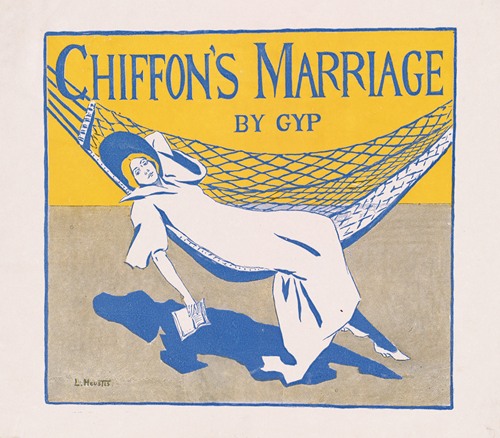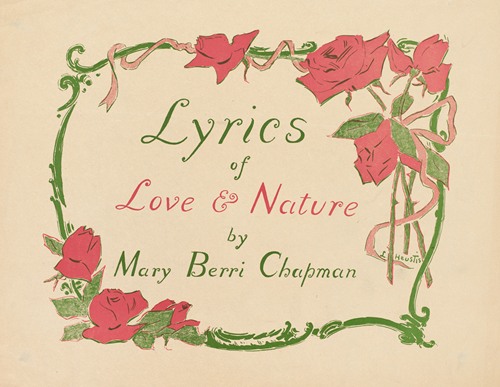

Portrait and landscape painter Louise Lyons Heustis was born in 1865 in Mobile, Alabama, of a well-educated, creative, and socially prominent family. She drew while yet a child. Early educated at home, Heustis later attended a girl's boarding school in Pass Christian, Mississippi, receiving her secondary education there. At the age of fifteen, the young artist-to-be lived with her grandparents in Philadelphia, taking a life class for two sessions at the Philadelphia Art Academy.
In 1887, she left for Europe for three years, traveling with friends, studying the masters, sketching and attending classes in Paris at the Academie Julian. Heustis studied with Robert Fleury, Jules Bastien-Lepage, Charles Lassar and William Adolfe Bouguereau, the latter praising her sketch, "Adam Cursing Cain," which won a prize at the Academie. Heustis then spent two years in Switzerland and Italy, and studied painting in Siena. She would later study in Paris with Frederick MacMonnies at the Academie Julian.
Returning to the United States upon the illness and death of her father, Heustis enrolled at the Art Students League in New York City. She studied with well-known artists Kenyon Cox and J. Alden Weir, including four years with William Merritt Chase at both the League and several summers at his Shinnecock, Long Island Art School.
She sold illustrations at this time for magazines like "Scribner's", "Century", "Ladies Home Journal", "Harper's", "Munsey", and "St. Nicholas", as well as illustrating novels and books, including her friend Rosalie Jonas's stories, "Augusta Evans's St. Elmo", and Emile Gaboria's "The Widow Lerouge".
Heustis became a successful and well-recognized painter of portraits, receiving many commissions to paint prominent individuals, families, and their children in New York, Norfolk, New Orleans, Cleveland, Philadelphia, Mobile and other cities. She also painted bank presidents, military generals, newspaper publishers and college professors. Her portraits appeared on the covers of magazines. In addition to portraits, Heustis also painted the historic sites of Newport, as well as the Mobile Market and Municipal Buildings, and other locations.
Heustis exhibited at the Chicago Art Institute, New York Academy of Design, the Philadelphia Academy, as well as frequent exhibitions in New York City, Chicago, Newport, New Orleans, Nashville, Memphis, Birmingham, and Mobile.
Prior to World War I, Heustis spent her summers studying and painting in Europe. There she met John Singer Sargent, Claude Monet, Frank Brangwyn and Edwin Austin Abbey during William Merritt Chase's summer art class trip to Europe in 1904, and later. During World War I, Heustis painted some summers in Southampton, Bar Harbor, and Provincetown. Her main summer studio, however, was in Newport, Rhode Island, where she was a popular figure as well as frequent prize winner in exhibitions there. She won the People's Prize of the Newport Art Association in 1921, 1926-1928, 1930 and 1936.
Other prizes won by Heustis include the 1925 Brown and Bigelow Competition; Nashville (Tennessee) Art Association in 1926; and the National Association of Women Painters and Sculptors' Nobel Prize for figure painting in 1932.
She was a member of the National Association of Women Painters and Sculptors, New York City. Her work is held in many private collections, as well as the Mobile Public Library, and Mobile Museum of Art in Alabama.
Though Louis Lyons Heustis died in New York City in 1951, her emotional ties were to Mobile and the South.
Like many artists approaching their deaths, Heustis was concerned about the fate of her paintings. In her will, she tried to endow her work to the Mobile Museum of Art in Alabama, where it would be held in a permanent collection, the Louise Lyons Heustis Gallery. She bequeathed eighty paintings, her personal papers and five thousand dollars, but, a tragic fire destroyed at least thirty of her paintings there, heavily damaging many more, and deflecting the realization of her endowment.
While the Mobile Art Association put on a Heustis exhibition in 1965, it took research into the artist's life and a search for her paintings in the 1990s by Paul Richelson, the Curator of American Art at the Mobile Museum of Art, to revive interest in Louise Lyons Heustis. The Museum put on an exhibition in 1995 to commemorate the 130th anniversary of Heustis's birth.

